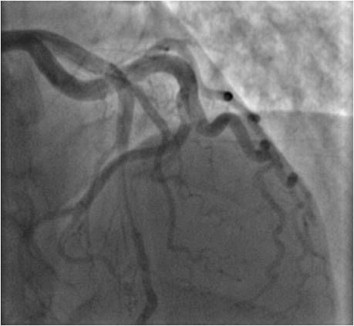Myocardial bridging is an anatomical variation characterized by narrowing during systole of some of the epicardial coronary arterial segments running in the myocardium. It can be encountered in 0.5 to 2.5% of routine coronary angiographies. Although it is considered as a benign anomaly it may lead to such complications as acute myocardial infarction, ventricular tachycardia, syncope, atrioventricular block and sudden cardiac death. We present doxazosin induced acute coronary syndrome in patient with myocardial bridging.
A 51-years old man was admitted in coronary intensive care unit due to syncope without any prodromal symptoms after taking doxazosin. The electrocardiogram showed sinus rhtym with biphasic T wave on precordial derivations. The concentration of the myocardial tissue-spesific biomarker, high sensitivity troponin T at 28 ng/L (99th percentile 14 ng/L) was detected high. A transthoracic echocardiogram showed left ventricular hypertrophy and diastolic dysfunction. His neurological examination was normal. His control high sensitivity troponin T at 42 ng/L (99th percentile 14 ng/L) was detected high. To further examine the coronary anatomy, the patient underwent coronary angiography, revealing a myocardial bridge confined to the LAD with mild systolic compression (Figure 1). The patient was initially treated with metoprolol and aspirin. The ECG holter monitoring was performed three times but any arrhytmia was not detected. Afterwards myocardial ischemia was investigated by Myocard perfusion scintigraphy. Myocard perfusion scintigraphy was normal in patient undergoing beta blocker treatment. The patient was discharged with beta blocker and acetylsalicylic acid and he has been followed up without any symptoms for 1 month.
In conclusion, besides nitrates other vasodilatator drugs like doxazosin can trigger acute coronary syndrome secondary to hypotension in patient with myocardial bridging.





